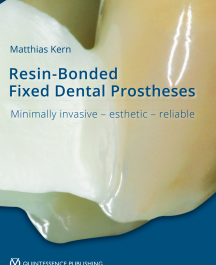Description
Chang, Ting-Ling / Orellana, Daniela / Beumer III, John
1st Edition 2019
Book
Hardcover, 21,6 x 27,9 cm, 240 pages, 748 images
Language: English
ISBN 978-0-86715-790-1
Quintessence Publishing, USA
In the 1960s, Professor F. J. Kratochvil recognized the importance of biomechanics in removable partial denture (RPD) design and used these principles to develop a new design philosophy. This “RPI system”—a clasp assembly consisting of a rest, a proximal plate, and an I-bar retainer—changed how clinicians approach partial denture design and is now used throughout the world. This textbook provides an overview of Kratochvil’s design philosophy and the basic principles of biomechanics it is based upon. Topics include components of RPDs and their functions, design sequences for maxillary and mandibular RPDs, and techniques for surveying and determining the most advantageous treatment position. A chapter dedicated to digital design and manufacturing of RPD frameworks highlights new technology in this emerging field. Additional topics include optimizing esthetic outcomes through attachments and rotational path RPDs as well as applying the RPI system to patients with maxillofacial defects. The authors provide illustrations of clinical cases throughout the book as well as an illustrated glossary of prosthodontic terminology. This textbook will prepare students and general practitioners to design and fabricate a biomechanically sound RPD framework for just about any dental configuration they encounter.
Contents
Chapter 01. Introduction to Removable Partial Dentures
Chapter 02. Removable Partial Denture Rests
Chapter 03. The Tooth-Tissue Junction and Proximal Plate Design
Chapter 04. Major Connectors, Minor Connectors, and Denture Base Connectors
Chapter 05. Retainers, Clasp Assemblies, and Indirect Retainers
Chapter 06. Types of RPDs, Biomechanics, and Design Principles
Chapter 07. Partial Denture Design Principles and Design Sequence
Chapter 08. Surveying and Determining the Most Advantageous Treatment Position
Chapter 09. Diagnosis, Treatment Planning, and Intraoral Preparation
Chapter 10. Impressions for the RPD Framework and Laboratory Instructions
Chapter 11. RPD Digital Design and Manufacturing
Chapter 12. Physiologic Adjustment of the RPD Casting and Altered Cast Impressions
Chapter 13. Maxillomandibular Records and Occlusion for RPDs
Chapter 14. Optimizing Esthetics: Attachments and Rotational Path RPDs
Chapter 15. Surveyed Crowns and Combined Fixed RPD Cases
Chapter 16. Overlay RPDs Using Retained Roots and Implants
Chapter 17. Using the RPI System for Defects of the Maxilla and Mandible
Chapter 18. Treatment Removable Partial Dentures
Chapter 19. Insertion and Maintenance of RPDs
Chapter 20. Clinical Appointment Sequence






Reviews
There are no reviews yet.